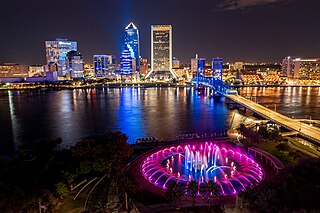
Jacksonville is a city located on the Atlantic coast of northeastern Florida, the most populous city proper in the state and the largest city by area in the contiguous United States as of 2020. It is the seat of Duval County, with which the city government consolidated in 1968. Consolidation greatly increased its population relative to its extended size which placed most of its metropolitan population within the city limits. As of July 2022, Jacksonville's population is 971,319, making it the most populous city in the Southeastern United States and the largest in the South outside the state of Texas. With a population of 1,733,937, the Jacksonville metropolitan area ranks as Florida's fourth-largest metropolitan region.
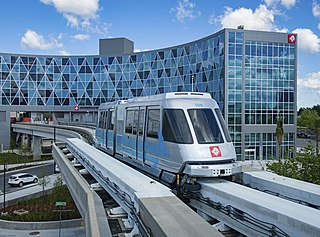
The Jacksonville Skyway is an automated people mover in Jacksonville, Florida. It opened in 1989 and is operated by the Jacksonville Transportation Authority (JTA). The skyway has three stations in Downtown Jacksonville and was extended in 1996 following a conversion from its original technology to Bombardier Transportation equipment. It was expanded again in 1998 and 2000. The currently fare-free system comprises two routes across 2.5 miles (4.0 km) of track, serving eight stations, and crosses the St. Johns River on the Acosta Bridge. In 2022, the system had a ridership of 276,600, or about 1,000 per day as of the first quarter of 2023.

Prime F. Osborn III Convention Center is a 265,000-square-foot (24,600 m2) convention center located in downtown Jacksonville, Florida. Opened in 1986, it was built incorporating Jacksonville Terminal Complex / Union Station as well as several thousand square feet of newly built structure.

Rosa Parks Transit Station is an intermodal transit station in Downtown Jacksonville, Florida. It is operated by the Jacksonville Transportation Authority (JTA) as a station for the Jacksonville Skyway elevated people mover. It previously served as Jacksonville's main city bus station before being replaced by the Jacksonville Regional Transportation Center at LaVilla in May 2020. It is located on Hogan Street between State Street and Union Street, and is the Skyway's northern terminus. It is across the street from the Downtown campus of Florida State College at Jacksonville.
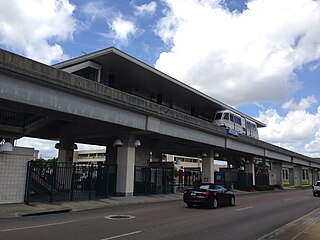
Jefferson station is a Jacksonville Skyway monorail station in Jacksonville, Florida. It is located on Bay Street just west of Jefferson Street in Downtown Jacksonville.
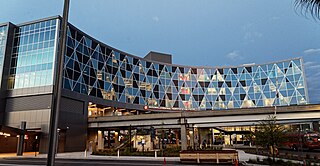
The Jacksonville Regional Transportation Center at LaVilla(JRTC) is an intermodal transit station in Jacksonville, Florida. It serves the Jacksonville Transportation Authority (JTA) bus system, the First Coast Flyer bus rapid transit (BRT) system, and the Jacksonville Skyway monorail, as well as home to JTA's administrative offices.

Downtown Jacksonville is the historic core and central business district (CBD) of Jacksonville, Florida. It comprises the earliest area of the city to be developed and is located in its geographic center along the narrowing point of the St. Johns River.
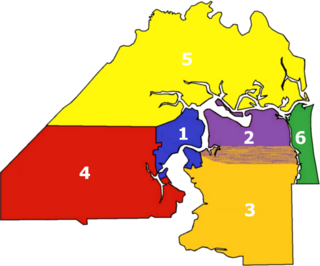
There are more than 500 neighborhoods within the area of Jacksonville, Florida, the largest city in the contiguous United States by area. These include Downtown Jacksonville and surrounding neighborhoods. Additionally, greater Jacksonville is traditionally divided into several major sections with amorphous boundaries: Northside, Westside, Southside, and Arlington, as well as the Jacksonville Beaches.
The LaVilla Museum is a museum of African American history and culture located in the 1929 Ritz Theater in Jacksonville, Florida. The museum opened in 1999.
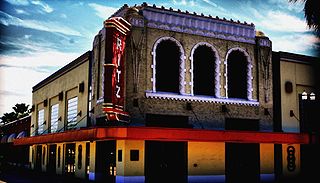
The Ritz Theatre is an African-American oriented theatre in the LaVilla neighborhood of Jacksonville, Florida. The theater, which seats 426, is used for a variety of music, dance and theatrical productions, as well as movies. The spacious lobby is also used for private functions. Just off the lobby is the LaVilla Museum which holds 11,000 square feet (1,000 m2) of exhibits. LaVilla is considered "the mecca for African American culture and heritage" in Florida.

The Jacksonville transportation network includes ground, air, and sea options for passenger and freight transit. The Jacksonville Port Authority (Jaxport) operates the Port of Jacksonville, which includes container shipping facilities at Blount Island Marine Terminal, the Talleyrand Marine Terminal and the Dames Point Marine Terminal. Jacksonville Aviation Authority managers Jacksonville International Airport in Northside, as well as several smaller airports. The Jacksonville Transportation Authority (JTA) operates bus, people mover, and park-n-ride services throughout the city and region. A major bus terminal at the intermodal Rosa Parks Transit Station serves as JTA's main transit hub. Various intercity bus companies terminate near Central Station. Amtrak operates passenger rail service to and from major cities throughout North America. The city is bisected by major highways, I-95 and I-10, I-295 creates a full beltway around the city.

Riverside and Avondale are two adjacent and closely associated neighborhoods, alternatively considered one continuous neighborhood, of Jacksonville, Florida. The area is primarily residential, but includes some commercial districts, including Five Points, the King Street District, and the Shoppes of Avondale.

Brooklyn is a neighborhood of Jacksonville, Florida, considered part of the downtown area. Originally a residential suburb, commercial uses became prominent during the 20th century, particularly along the St. Johns River and Riverside Avenue, and the area became included in Jacksonville's central business district. In the 21st century, it has become the site of mixed-use developments.

The Southbank is a neighborhood of Jacksonville, Florida, considered part of the Urban Core.
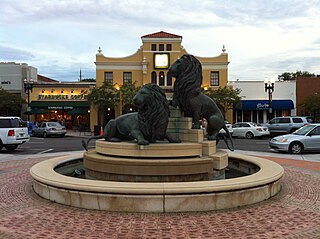
San Marco is a neighborhood of Jacksonville, Florida, south of Downtown across the St. Johns River. The neighborhood was formerly the independent city of South Jacksonville until it was annexed by Jacksonville in 1932. The neighborhood is primarily residential, with an integrated commercial sector known as San Marco Square.

New Town is a neighborhood of Jacksonville, Florida. A primarily residential neighborhood, it is located in Jacksonville's Urban Core, immediately northwest of Downtown.

The First Coast Flyer is a bus rapid transit (BRT) system in Jacksonville, Florida, owned and operated by the Jacksonville Transportation Authority (JTA). It currently consists of four radial routes running north, southwest, southeast, and east from the Jacksonville Regional Transportation Center in Downtown Jacksonville, where it connects to the Jacksonville Skyway. The first phase, including stations in Downtown Jacksonville and the northbound Green Line, opened in December 2015, with the southbound Blue Line opening in 2016. Additional phases, including the eastbound Red Line and southwestern Orange Line opened in 2018 and 2021, respectively.

Laura Street is a north–south street in Jacksonville, Florida, United States, named for the daughter of the city's founder, Isaiah D. Hart. Historically, the downtown portion of Laura Street has been considered the financial district of Jacksonville.

The Richmond Hotel is a historic building located in the LaVilla neighborhood of Jacksonville, Florida. The building was originally built in 1909 as a hotel for Black patrons. Following desegregation, the hotel closed in 1969. As of 2018, the ground-level area of the Richmond Hotel is occupied by Delo Studios.
























